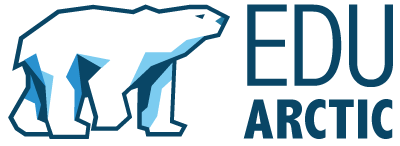Videos
Can ice be warm? How fast can the glaciers move? Can water flow between ice crystals? These and other questions will be answered by a glaciologist Prof. Piotr Głowacki, a longtime manager of the Polish Polar Station Hornsund.
Presenter: Piotr Głowacki
Earth’s history contains 4,5 billion years, life appear around 3,7 billions of years ago, the extinct of dinosaurs have place around 65 millions of years ago. All of these are big number, but how to imagine them?
During this lesson we will compare 4,5 billion years of Earth’s history into one year and show the most important and interesting facts about the Earth’s history.
Presenter: Agata Bury
Dasher, Dancer, Prancer, Vixen, Comet, Cupid, Donner and Blitzen. And, of course, Rudolph: the red-nose one.
Santa Claus reindeers can fly. In real life, those amazing creatures are no less fascinating.
Presenter: Anna Wielgopolan
The loss of sea ice in the Arctic, particularly in summer, causes a dramatic reduction in the surface albedo of the Arctic region as well as enabling greater energy exchange between the atmosphere and ocean.
Paradoxically, warm Arctic can mean heavy snow, blizzards and freezing rain in Europe. How come?
Ice much reflects the sun's rays much stronger than water surface, which is why areas free of ice and snow get warmer faster. From the sea, which is not covered with ice, the water evaporates more easily, so more water vapor enters the atmosphere, which also results in higher precipitation also over the land as a result of the movement of air masses. So it has its reflection in the atmosphere and strongly affects the air circulation in the European Arctic sector. racking the changes in the Arctic ice sheet helps in forecasting what is possibly waiting for us not only in the coming days, but even in the long-term perspective.
Presenter: Piotr Głowacki
Khanty, Nenets, Chukchi, Buryats, Yakuts... Indigenous people inhabiting one of the coldest territories on Earth - Russian Arctic. During classes we will travel through Siberia - region, which northern border reaches the Arctic Ocean, and in the west it borders with the Ural Mountains.
Presenter: Dagmara Bożek-Andryszczak
Controlling weather, shaping climate, preventing catastrophc events, designing seasons ....sounds like a dream come true, an ultimate triumph of science. But is it really? What are the hazards? Meet geoengineering techniques and their potential consequences.
Presenter: Anna Wielgopolan
It's "raining' ... Sun? "Chilly, with chance for auroras"? Solar flares, meteor showers, Northern Lights and the sun-Earth environment. Learn all about space weather. Should we be afraid of it? Is there a "space climate"?
Presenter: Anna Wielgopolan
Moon, Mars....Universe. Great missions that go to investigate other planets must first be tested on Earth. What if, one day, humanity has to abandon our planet and search for new home? Can we use polar experience for preparation? Are difficult, extreme conditions a perfect laboratory of space life?
Presenter: Anna Wielgopolan
Fighting skills, adventurous spirit, cruelty and fearlessness. We all love those legendary northern warriors, depicted widely in pop-culture. learn all about Arctic Conquerors, their everyday life, beliefs and less know facts.
Presenter: Anna Wielgopolan
Does the flap of a butterfly’s wings in Brazil set off a tornado in Texas? While most traditional science deals with supposedly predictable phenomena like gravity, electricity, or chemical reactions, Chaos Theory deals with nonlinear things that are effectively impossible to predict or control, like turbulence, weather, the stock market, our brain states, and so on. Can we use chaos for climate predictions? What's the science behind this concept?
Presenter: Anna Wielgopolan
Are you an early bird or a lark? When do you go to bed? When do you learn best? Do you sleep better in winter or in summer? Sleep is only one of the many processes timed by an internal clock. All organisms have biological clocks to deal with the demands of the rhythmic change of day and night, light and darkness. Biological clocks control times of rest and activity in a 24 hour day, but also seasonal changes such as the best times to migrate, hibernate, gain weight or when to change fur or plumage. Sun light is the most important signal for biological clocks. The times of sunrise and sunset and the position of the sun in the sky tell the body what time of day and year it is. But what if there is no light? What if there is no darkness? Welcome to the Arctic! Find out how nature copes with month after month of day – or night.
Presenter: Gabi Wegner
Lesson is conducted directly from the polar station! The Northern Lights or Aurora Borealis is a natural phenomenon that can paint the night sky with unearthly, surreal color. Find out what are the Northern Lights, learn about how are being formed and get know interesting facts about Aurora!
Presenter: Teresa Biernacka

 This project (EDU-ARCTIC) has received funding from the European Union’s Horizon 2020 research and innovation programme under grant agreement No 710240. The content of the website is the sole responsibility of the Consortium and it does not represent the opinion of the European Commission, and the Commission is not responsible for any use that might be made of information contained.
This project (EDU-ARCTIC) has received funding from the European Union’s Horizon 2020 research and innovation programme under grant agreement No 710240. The content of the website is the sole responsibility of the Consortium and it does not represent the opinion of the European Commission, and the Commission is not responsible for any use that might be made of information contained.